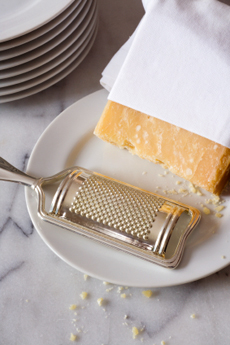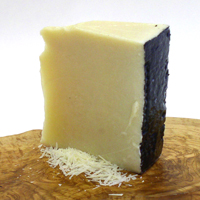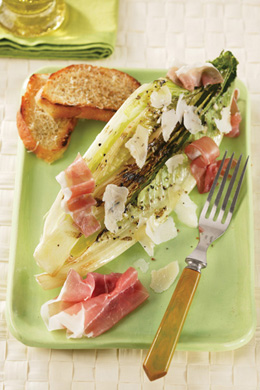

Get ready to grate! Photo by Y. Yang | IST.
|
STEPHANIE ZONIS focuses on good foods and the people who produce them. KAREN HOCHMAN is Editorial Director of THE NIBBLE.
|
|
September 2007
Last Updated February 2014
|
 |
Grating Cheese: It’s Great To Grate
Page 7: Pecorino Romano Cheese
This is Page 7 of an eight-page article on grated cheese. Click on the black links below to visit other pages.
Pecorino Romano
The last cheese in our “grate” foursome is pecorino. Pecorino Romano is Italy's oldest cheese, dating back more than two thousand years, to ancient Roman times. The first recorded description dates back to the 1st century C.E.; we know that one ounce of Pecorino Romano was part of the Roman legionnaire’s daily rations (one ounce seems pretty paltry for a fighting man!).
 Pecorino is a hard, hearty sheep’s milk cheese of southern Italian origin, typically aged for one year and used as a grating cheese. It is now produced in various regions of Italy, each producing a slightly different variation. Pecorino is not a designation-protected cheese; while the three preceding cheeses specify an area in which they must be produced—Parma, the Po Valley or the township of Asiago—“pecorino” comes from the Italian word for sheep, pecora. Pecorino is a hard, hearty sheep’s milk cheese of southern Italian origin, typically aged for one year and used as a grating cheese. It is now produced in various regions of Italy, each producing a slightly different variation. Pecorino is not a designation-protected cheese; while the three preceding cheeses specify an area in which they must be produced—Parma, the Po Valley or the township of Asiago—“pecorino” comes from the Italian word for sheep, pecora.
Pecorino Romano was traditionally produced in and around Rome, although by the 19th century, increasing consumer demand, the development of the land around Rome and the existence of an established tradition in Sardinia of making sheep’s milk cheeses, prompted some of the major manufacturers to relocate their production to the island of Sardinia. Other Pecorinos are now marketed, such as Pecorino Toscano, Pecorino Sardo and Pecorino Siciliano. Each has a different, though also sharp, taste. And, Romano cheese, a grating cheese made in the U.S., can further confuse many people. It is a commercial cheese generally made from cow’s milk, with not much in common with a Pecorino Romano, except that it grates.
As a sheep’s milk cheese, Pecorino is somewhat whiter in color than the golden-to-amber aged cow’s milk grating cheeses. It’s also the sharpest and strongest of the group, and often the most salty, too—although the least nuanced in flavor.
Made in 65-pound wheels, Pecorino is aged for about eight months if it’s to be used as a grating cheese, less time if it is to be used as a table cheese. Cheese expert Steven Jenkins notes that only four brands—Fulvi, Locatelli (yes, this is a brand, and not the name of a cheese), Brunelli and Lopez—are true “Romano” Pecorinos (a.k.a. “genuine” Pecorino Romano cheeses); that is, they are still made in the province of Rome. The Roman cheeses are never as hard or dry as the Sardinian-made cheeses, and can be enjoyed as table cheeses.
The longer a Pecorino Romano is aged, the sharper it becomes; and the bold, pungent flavor of this cheese enlivens dishes. For those not seeking the complexities of a Parmigiano or a Grana or the subtleness of Asiago, it adds a different but very pleasing personality to pasta.
|

A Caesar salad is traditionally made with Parmigiano-Reggiano. But for value, substitute Pecorino Romano. And, try this “deconstructed” Caesar, with half a head of romaine, shaved cheese, prosciutto and garlic bread, instead of torn lettuce, grated cheese, anchovies and croutons, Photo courtesy of the Consorzio di Prosciutto di Parma. |
Anyone raised in southern Italy may well swear by Pecorino, as it’s the most often-used grating cheese (perhaps, the most often used cheese, period) in that part of the country.
Wine Pairing
Whatever food you are serving will likely dictate your choice of wine here. A nice suggestion is Montepulciano d’Abruzzo or Velletri Rosso.
Continue To Page 8: Cheese Tasting Party
Go To The Article Index Above
Lifestyle Direct, Inc. All rights reserved. Images are the copyright of their respective owners.

|





 Pecorino is a hard, hearty sheep’s milk cheese of southern Italian origin, typically aged for one year and used as a grating cheese. It is now produced in various regions of Italy, each producing a slightly different variation. Pecorino is not a designation-protected cheese; while the three preceding cheeses specify an area in which they must be produced—Parma, the Po Valley or the township of Asiago—“pecorino” comes from the Italian word for sheep, pecora.
Pecorino is a hard, hearty sheep’s milk cheese of southern Italian origin, typically aged for one year and used as a grating cheese. It is now produced in various regions of Italy, each producing a slightly different variation. Pecorino is not a designation-protected cheese; while the three preceding cheeses specify an area in which they must be produced—Parma, the Po Valley or the township of Asiago—“pecorino” comes from the Italian word for sheep, pecora. 